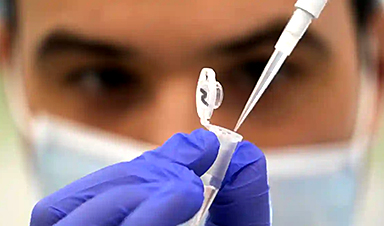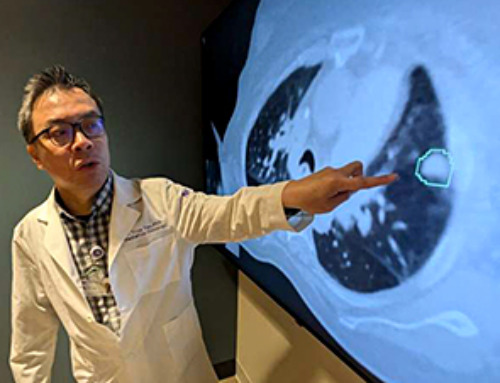British researchers are developing a groundbreaking technology to monitor genetic changes in respiratory viruses as they circulate round the world. The system is to be used to pinpoint dangerous new variants as they emerge and act as an early warning system for new diseases and future pandemics.
The team, which is based at the Wellcome Sanger Institute in Cambridgeshire, intends to make the technology cheap, easy to use and capable of being scaled up to provide global surveillance of a wide range of viruses. Targets would include influenza viruses, respiratory syncytial virus (RSV), coronaviruses and previously unknown pathogens.
The ultimate aim of the project – the Respiratory Virus and Microbiome Initiative – is to create a system that would deploy DNA sequencing technology to identify all viral, bacterial and fungal species in a single sample collected from a nose swab from a patient.
“The knowledge and data we generated allowed us to track – with unprecedented speed and accuracy – Sars-CoV-2, the virus responsible for Covid-19, and to monitor how it was changing. It was a wonderful aid in helping to fight the disease. Now we are aiming to contribute building a global genomic surveillance for all respiratory viruses. These, after all, are the agents most likely to trigger new pandemics,” Harrison added.
An illustration of the threat of future pandemics is provided by coronaviruses. Three times in the past 20 years, a previously unknown coronavirus emerged to infect humans: Sars in China and neighbouring countries; Mers in the Middle East; and Covid-19, which affected the whole planet.
However, it was the use of genomic surveys during the Covid pandemic that revealed the technology’s remarkable potential. In December 2020, when there was a sudden rise in Covid cases in south-east England, the technology showed that this surge had been triggered by the appearance of a new, more infectious variant. Known originally as the Kent strain, it was later relabelled the Sars-CoV-2 Alpha variant.
“The discovery was a gamechanger,” said John Sillitoe, leader of the Sanger Institute’s genomic surveillance unit. “We generated genomic data very quickly and could see that this variant was transmitting at a very high rate. Suddenly, the world could see what genomics could do. It allows you to see changes in viruses much, much more quickly than by other methods, and now we are going to exploit that power.”
The Sanger team is collaborating with the UK Health Security Agency, British academics, and other public health bodies on the project, with the aim of developing techniques that will allow them to sequence – from a single sample – not just one virus variant but any that might be infecting a patient. Typically, samples would be taken from individuals newly admitted to a hospital, where signs of a new, emerging disease are likely to first appear.
However, such technology would have to be adaptable to laboratories around the world. “It would be no good if the UK and one or two other developed countries learned how to sequence respiratory virus genomes and no one else,” added Sillitoe. “If we don’t have this kind of surveillance globally, we’re not going to spot a dangerous new variant until it has already spread over much of the planet.”
For the system to work across the globe, it would have to be the easiest, cheapest, fastest and most amenable to scaling that could be designed, said Sillitoe. “In many labs around the world, people have smaller sequencing machines and cannot sequence as many samples as we can at the Sanger. So we want the system to work equally well on those machines as it does here on our large volume devices.”
Harrison told the Observer that three different versions of the technology were now being tested. “Over the coming months, we will be seeing if we can swap bits and possibly come up with a hybrid in the end. The aim would be to get a usable system in operation in a year, although there will always be room for improvements after that,” he added.
“The crucial point is that we have got to develop a system that uses inexpensive reagents, does not require teams of highly-trained technicians and can be used at scale. Then we can really make a difference.
“At present, for many respiratory viruses, we have sequenced maybe 1,000-2,000 of their genomes. We want to create hundreds of thousands of genomes for each of them in the near future. The information they will provide will be priceless, not just in tracking a new disease but in speeding up vaccine and drug development.”
The team at the Sanger Institute is not the only group of scientists working on expanding genomic surveys to cover many other emerging viruses. Centres in the US and in Germany are also working on similar projects.
News
Johns Hopkins Researchers Uncover a New Way To Kill Cancer Cells
A new study reveals that blocking ribosomal RNA production rewires cancer cell behavior and could help treat genetically unstable tumors. Researchers at the Johns Hopkins Kimmel Cancer Center and the Department of Radiation Oncology and Molecular [...]
AI matches doctors in mapping lung tumors for radiation therapy
In radiation therapy, precision can save lives. Oncologists must carefully map the size and location of a tumor before delivering high-dose radiation to destroy cancer cells while sparing healthy tissue. But this process, called [...]
Scientists Finally “See” Key Protein That Controls Inflammation
Researchers used advanced microscopy to uncover important protein structures. For the first time, two important protein structures in the human body are being visualized, thanks in part to cutting-edge technology at the University of [...]
AI tool detects 9 types of dementia from a single brain scan
Mayo Clinic researchers have developed a new artificial intelligence (AI) tool that helps clinicians identify brain activity patterns linked to nine types of dementia, including Alzheimer's disease, using a single, widely available scan—a transformative [...]
Is plastic packaging putting more than just food on your plate?
New research reveals that common food packaging and utensils can shed microscopic plastics into our food, prompting urgent calls for stricter testing and updated regulations to protect public health. Beyond microplastics: The analysis intentionally [...]
Aging Spreads Through the Bloodstream
Summary: New research reveals that aging isn’t just a local cellular process—it can spread throughout the body via the bloodstream. A redox-sensitive protein called ReHMGB1, secreted by senescent cells, was found to trigger aging features [...]
AI and nanomedicine find rare biomarkers for prostrate cancer and atherosclerosis
Imagine a stadium packed with 75,000 fans, all wearing green and white jerseys—except one person in a solid green shirt. Finding that person would be tough. That's how hard it is for scientists to [...]
Are Pesticides Breeding the Next Pandemic? Experts Warn of Fungal Superbugs
Fungicides used in agriculture have been linked to an increase in resistance to antifungal drugs in both humans and animals. Fungal infections are on the rise, and two UC Davis infectious disease experts, Dr. George Thompson [...]
Scientists Crack the 500-Million-Year-Old Code That Controls Your Immune System
A collaborative team from Penn Medicine and Penn Engineering has uncovered the mathematical principles behind a 500-million-year-old protein network that determines whether foreign materials are recognized as friend or foe. How does your body [...]
Team discovers how tiny parts of cells stay organized, new insights for blocking cancer growth
A team of international researchers led by scientists at City of Hope provides the most thorough account yet of an elusive target for cancer treatment. Published in Science Advances, the study suggests a complex signaling [...]
Nanomaterials in Ophthalmology: A Review
Eye diseases are becoming more common. In 2020, over 250 million people had mild vision problems, and 295 million experienced moderate to severe ocular conditions. In response, researchers are turning to nanotechnology and nanomaterials—tools that are transforming [...]
Natural Plant Extract Removes up to 90% of Microplastics From Water
Researchers found that natural polymers derived from okra and fenugreek are highly effective at removing microplastics from water. The same sticky substances that make okra slimy and give fenugreek its gel-like texture could help [...]
Instant coffee may damage your eyes, genetic study finds
A new genetic study shows that just one extra cup of instant coffee a day could significantly increase your risk of developing dry AMD, shedding fresh light on how our daily beverage choices may [...]
Nanoneedle patch offers painless alternative to traditional cancer biopsies
A patch containing tens of millions of microscopic nanoneedles could soon replace traditional biopsies, scientists have found. The patch offers a painless and less invasive alternative for millions of patients worldwide who undergo biopsies [...]
Small antibodies provide broad protection against SARS coronaviruses
Scientists have discovered a unique class of small antibodies that are strongly protective against a wide range of SARS coronaviruses, including SARS-CoV-1 and numerous early and recent SARS-CoV-2 variants. The unique antibodies target an [...]
Controlling This One Molecule Could Halt Alzheimer’s in Its Tracks
New research identifies the immune molecule STING as a driver of brain damage in Alzheimer’s. A new approach to Alzheimer’s disease has led to an exciting discovery that could help stop the devastating cognitive decline [...]





















